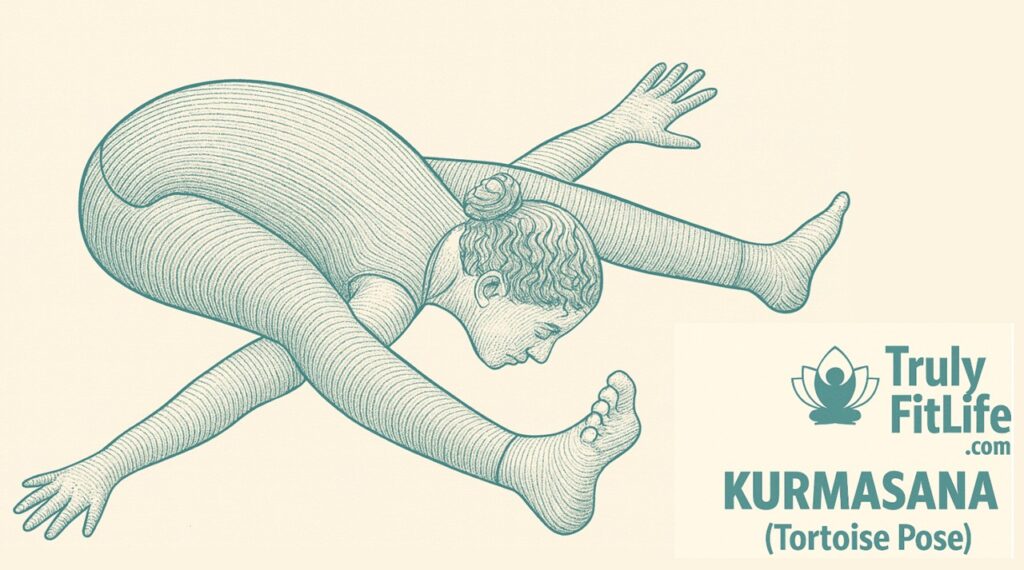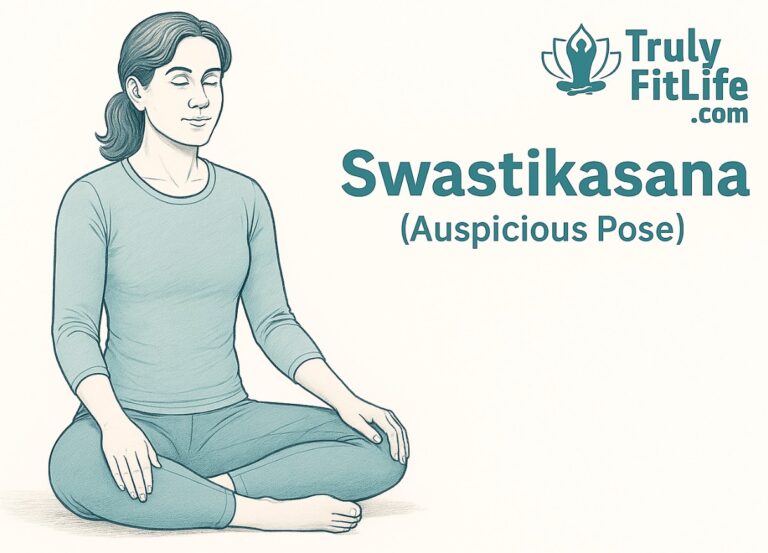
Kurmasana (Tortoise Pose) is a classical forward-bending posture named after the tortoise (Kurma in Sanskrit). The asana resembles a tortoise withdrawing into its shell, symbolizing retreating inward, detachment from distractions, and deep inner awareness.
This is considered an advanced asana, requiring open hips, flexible hamstrings, and strong forward-bending ability. It is mentioned in the Hatha Yoga Pradipika and remains a key posture in Ashtanga Yoga series. Practicing Kurmasana brings profound physical, mental, and spiritual benefits, though it should be approached with patience and care.
Step-by-Step Instructions to Practice Kurmasana – Tortoise Pose
1. Starting Position
- Sit in Dandasana (Staff Pose) with legs extended forward.
- Keep the spine tall and shoulders relaxed.
2. Leg Placement
- Spread the legs wide, slightly wider than hip-width.
- Bend knees gently to prepare for forward folding.
3. Arm Positioning
- Exhale and lean forward from the hips.
- Slide both arms under the thighs, palms facing downward.
4. Full Expression of Pose
- Gradually extend the legs outward, straightening knees as flexibility allows.
- Stretch the torso forward and lower chest toward the floor.
- Keep the chin or forehead close to the mat.
5. Breathing & Hold
- Breathe slowly and deeply.
- Hold for 20–40 seconds initially, increasing up to 1–2 minutes with practice.
6. Releasing
- Inhale and gently lift torso back to upright position.
- Return legs together into Dandasana.
Key Alignment Tips
- Initiate the fold from hips, not the lower back.
- Keep feet flexed to protect knees.
- Do not force legs or back—go only as far as flexibility permits.
- Use props (bolsters or blocks) to support chest if needed.
Benefits of Kurmasana – Tortoise Pose
🦴 Physical Benefits
- Deep Forward Stretch: Improves flexibility of spine, hamstrings, and hips.
- Strengthens Back: Builds spinal endurance and alignment.
- Stimulates Digestion: Compresses abdominal region to massage organs.
- Enhances Circulation: Boosts blood flow to spine and brain.
- Therapeutic Effects: Can relieve mild backache and sciatica when practiced gently.
🧘♂️ Mental & Emotional Benefits
- Calms the Nervous System: Encourages introversion and stillness.
- Relieves Stress & Anxiety: Forward bends are grounding and soothing.
- Promotes Inner Awareness: Symbolizes turning inward like a tortoise.
- Supports Meditation: Prepares body and mind for deep states of silence.
Contraindications & Precautions
- ❌ Avoid if you have slipped disc, herniated spine, or chronic back issues.
- ❌ Not suitable for recent hip or shoulder injuries.
- ⚠️ Beginners should not attempt without proper warm-up.
- ⚠️ Pregnant women must avoid deep forward bends.
👉 Modification: Place a bolster under chest and keep knees bent to reduce strain.
Modifications & Variations
- Supported Kurmasana: Use props for chest support.
- Half Kurmasana: Slide only one arm under one leg for beginners.
- Supta Kurmasana (Sleeping Tortoise): An advanced variation with legs crossed behind head and arms bound under back.
Drishti (Gaze Point)
- Nasagra Drishti (Tip of Nose): Enhances internal focus.
- Closed Eyes: Encourages deeper meditative awareness.
Chakras Activated
- Muladhara (Root Chakra): Provides stability and grounding.
- Svadhisthana (Sacral Chakra): Enhances pelvic energy and flexibility.
- Ajna (Third Eye Chakra): Supports inner awareness and meditation.
Practice Suggestions
- Warm up with hip openers (Baddha Konasana, Upavistha Konasana).
- Practice after sun salutations when body is warm.
- Perform Kurmasana as part of Ashtanga Primary Series or forward bend sequence.
- Follow with counterposes like Bhujangasana (Cobra Pose) or Setu Bandhasana (Bridge Pose).


